DIVERSITY IN LIVING ORGANISMS for Class 9 BIOLOGY
INTRODUCTION
- Different forms of living organism or a variety of life forms found in a particular region. This is known as Biodiversity. There are about 1.7 million species of organisms known on this earth which differ from one another in external form, internal structure, mode of nutrition, habitat, etc.
There is a branch of biology called Taxonomy which deals with the identification, nomenclature and classification of organisms. Carolus Linnaeus is known as the Father of the Taxonomy.

CHAPTER WEIGHTAGE
- Yeh ek important chapter hai jisse kai question puche jate hain. Isme Nomenclature ya kingdoms ke characters puche jaa skte hai to ise dhyaan se padhna hoga. Sath me hai yeah biology padhne ki ek basic step hai jo sabhi biology padhne wale bacho ko pta hona chahiyeah kyunki yhi chapter hume btyaega ki kitne livings organisms hai jo scientists identify kar chuke hai, unke common character kya hai, kaise wo ek dusre se jude hue toh yeah chapter nya hai or sath hi me interesting and lengthy bhi, so be focused.
CLASSIFICATION OF LIVING ORGANISM
- Jaise hum sab jante hain ki iss dharti par alag-alag tarah ke prani rehte hain. Koi chota koi bada. Even plants mein bhi hame variety dekhne ko milti hai. Toh diversity ka simple sa matlab hai yeah : bhinnata, yani ki jo alag alag tarah ki life forms hai inhi ko hum angrezi me "diversity in living organisms" kehte hai.
- Ek example se samjhne ki koshish karte hai : Ab mein apko kahoon ki aap aapne pariwar ke logon ko categorize karo matlb male alag female alag aise group bnao. Uske baad male group ko bhi further divide karo chote bacho mein, bado mein or elder people mein. Same yahi aap female group ke sath kro yani choti bachi alag badi female alag or elder female alag. Yahi hai classification.
- Yani categories mein divide karna. Ab yaha to humne ek parameter le lia jo hai age or gender ki bhyii iss age ke male alag and issi age ki females alag group me. Lekin agar hum is prithvi ke sabhi living organism ki baat karen to hum kai parameters ke basis pe in organism ko kai groups meine divide kar skte hain.
- Ab kyuki is dharti pe lakhon karodon organisms hai to kya aap sbke bare mein jan skte ho? Padh skte ho? Nahi naa. Isi wjah se hum inhe alag alag categories mein divide karke classify kar dete hain or ek jaise organism ko ek jagah rkhte hain. Jisse hum unhe aasani se padh ske unke bare mein jaan sake ki wo kaha se ae hai kaise paida hue hai, wo dikhne mein kaise hain, unme kya hai jo dusro se unhe alag karta hai, wagerah wagerah.
CLASSIFICATION OF LIVING ORGANISM
- It makes study of a wide variety of organisms convenient and easy.
- It is not easy for someone to know about all organisms but by studying a few taxonomic groups we get a general idea of all life forms at a glance.
- It reveals the interrelationship among different groups of organisms.
- It will help us in understanding how these organisms evolved.
- We can also understand how different organisms are related to each other.
- We can learn why different organisms are found at distinct geographical conditions.
Basis of classification:
The method of arranging organisms into groups or sets on the basis of similarities, differences and relationship is known as Classification.The system of classification which is based on one or few arbitrarily chosen criteria such as habitat or one or more major habitats of organisms is called Artificial classification.
Importance of Classification:
Evolution:
Over a course of time the living organisms accumulate changes. These changes could be in their body type or size or their features which allow them to survive better with the change in environment. This is called Evolution. It is a slow and continuous process. It leads to the formation of new organisms and more diversity in the ecosystem This concept was introduced by Charles Darwin in 1859 in his book ‘The origin of species’.Primitive Organisms are the ones that have an ancient body design - one without any well defined nucleus and without any membrane bound cell organelles. Their bodies haven't undergone many changes with time. They are also called Lower organisms. The Advanced Organisms are those who have recently acquired body changes. They are also called Higher organisms.
TAXONOMICAL HIERARCHY
- Hierarchy ek system hota hai jisse hum kisi bhi cheej ko organise karte hain different ranks (yani ki levels par jaise game hota haina level 1 and level 2 aise hi biology me classification karte hue levels ya taxonomic ranks hoti hai.) kuch important points ya kuch characters ke basis pe. Iska seedha sa ye matlab hai ki jo sabse important hota hai ya jo main cheej hai wo top pe fr uske according rank krte jao. Jaise humne upar ek example lia tha ki family members ko categorise kia tha. To main point to gender lia tha ki male hai ya female. To sabse upar hierarchy mein aaya gender. Fr uske baad hum age factor ko rakhenge. Yeh hota hai hierarchy (yani ki different levels. Game me jaise jaise level badhta jata hai waise waise game mushkil hojati hai. Right? Aise hi bio me classification karte hue sabse badi rank/level hai "kingdom", fir ek hi kingdom me bahut sare or chote chote divisions/phyla hote hai and so on.....). Cheezon ko rank karna.
- To jab hum organisms ko classify karte hain, to hum dekhte hain ki kis kisme jada similar characters hain. Jo jada ek jaise lagte hain unhe hum ek group mein rakh dete hain. Fir in group ko hum usse bde group mein rakh dete hain similarity ke basis pe. In group ko taxonomic group bhi kehte hain. Or yeh jo category banti hai us har category ka naam hai. Ab example ke lia hum lete hain hum humans ko hi.
- Hum kya hai animals, haina. Animals mein hum hai chordates qki hamare paas backbone hoti hai. Ab chordates to or bhi honge jaise birds reptiles yeh bhi chordates hote hain. Lkin chordates mein hum ate hain mammals mein kyuki hamare pas hair or mammary glands hote hain. Ab dkho yeh jo animals category thi yeh sabse badi category hai kyuki animals to bhut sare hain. Toh yeh hai kingdom (simply relate kare toh kingdom ka matlab hai "rajay" or wahi matlab yhan par hai ki animals ka apna alag rajya hua, plants ka alag, bacteria ka alag jo hum aage ek ek karke padhenge.). Sabse badi category hoti hai kingdom. Fir uske baad aati hai phylum ya division. Plants hoga to hum division kahenge or animal hoga to hum phylum kahenge. Fr uske baad aata hai class, then order, family, genus or sabse akhir mein aata hai species. Jaise hum humans hote hain Homo sapiens. Isme Homo hai genus name or sapiens hai species name. Isi tarah yeh hai taxonomical hierarchy.
TAXONOMICAL HIERARCHY
- Species: It is the lowest category regarded as a basic unit of classification. It is the level of classification which consists of a number of organisms with similar characteristics and can interbreed to give rise to a fertile offspring and probably descend from a common ancestor.
- Genus: It is a group of closely resembling species having a common ancestry. All the species in a genus show similarities in broad features of their organisation but differ in minor details.
- Family: It represents a larger group of closely related genera. It is composed of one or more genera.
- Order: It is the level of classification which consists of a number of families with similar characteristics.
- Class: It is a group of related orders.
- Phylum/Division: Phylum(in case of animals) or Division (in case of plants) is a group of related classes.
- Kingdom: It is the highest level of classification which consists of a number of phyla or divisions with similar characteristics.
Hierarchy of Classification
In classification the organisms that closely resemble each other are placed in a group. These groups are further placed in larger groups on the basis of similarities. The larger groups are placed in still larger groups. The various grouping levels or ranks in classification are known as categories.Linnaeus proposed a classification system by arranging organisms into taxonomic groups at different levels or categories according to the characteristics they have. Each category has its specific name. There are major seven categories: Remeber that some animals, as we will learn in future sections of this chapter, are indeed sessile.
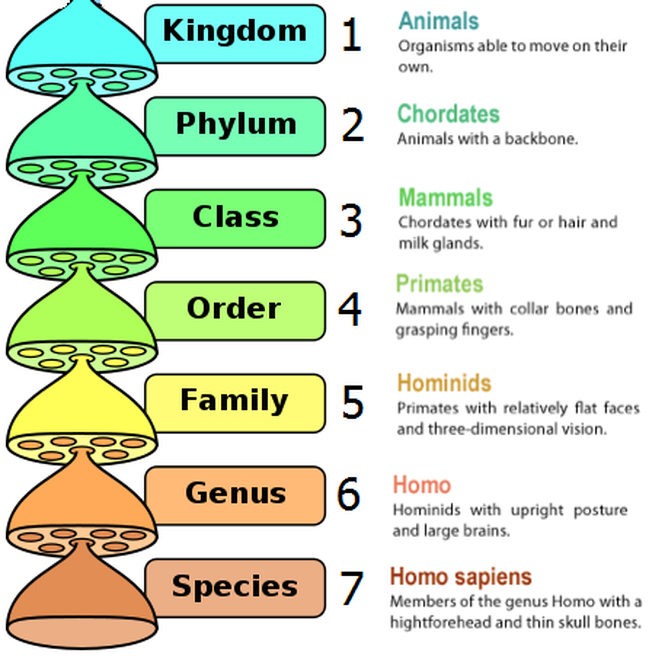

CLASSIFICATION SYSTEM
- Ab jo hum organisms ko classify kar rahe hai wo kaise karte hai wo padhenge. Pahle kya tha ek two kingdom classification tha. Jisme Carolus Linnaeus ne 1758 mein living organisms ko two groups mein divide kia tha plants and animals.. Lkin is classification ka drawback ye hai ki jab thode time baad unicellular organisms discover hue to woh na to plants mein na animals ki category mein fit hue jaise ki euglena or viruses and Bacteria and Fungus. Toh fir kuch or systems aay classification ke lekin kuch na kuch dikkat thi unme. Kabhi kisi ko particular jagah ni milti toh kabhi kisi ko toh finally baad me R.H. Whittaker ne 1969 mein five kingdom classification dia jisme first kingdom tha Monera, then Protista, Fungi, Plantae and Animalia.
CLASSIFICATION SYSTEM
- Two kingdom classifications: Carolus Linnaeus in 1758 classified the living organisms into two groups as plants and animals.
Drawbacks: With the passage of time certain unicellular organisms were identified which did not strictly fit either into Plant or Animal kingdom. For eg; (i) Euglena had some characteristics of both plants and animals. (ii)Viruses belong to neither plant nor animal kingdom. - Five kingdom classification: Robert H. Whittaker in 1969 further classified the organisms into five kingdoms as:
- Kingdom Monera: It includes prokaryotic bacteria, cyanobacteria, actinomycetes, archaebacteria, etc.
- Kingdom Protista: It includes unicellular eukaryotic organisms such as unicellular algae, slime moulds and protozoans.
- Kingdom Fungi: It includes all fungi
- Kingdom Plantae: It includes multicellular green plants.
- Kingdom Animalia: It includes multicellular animals.

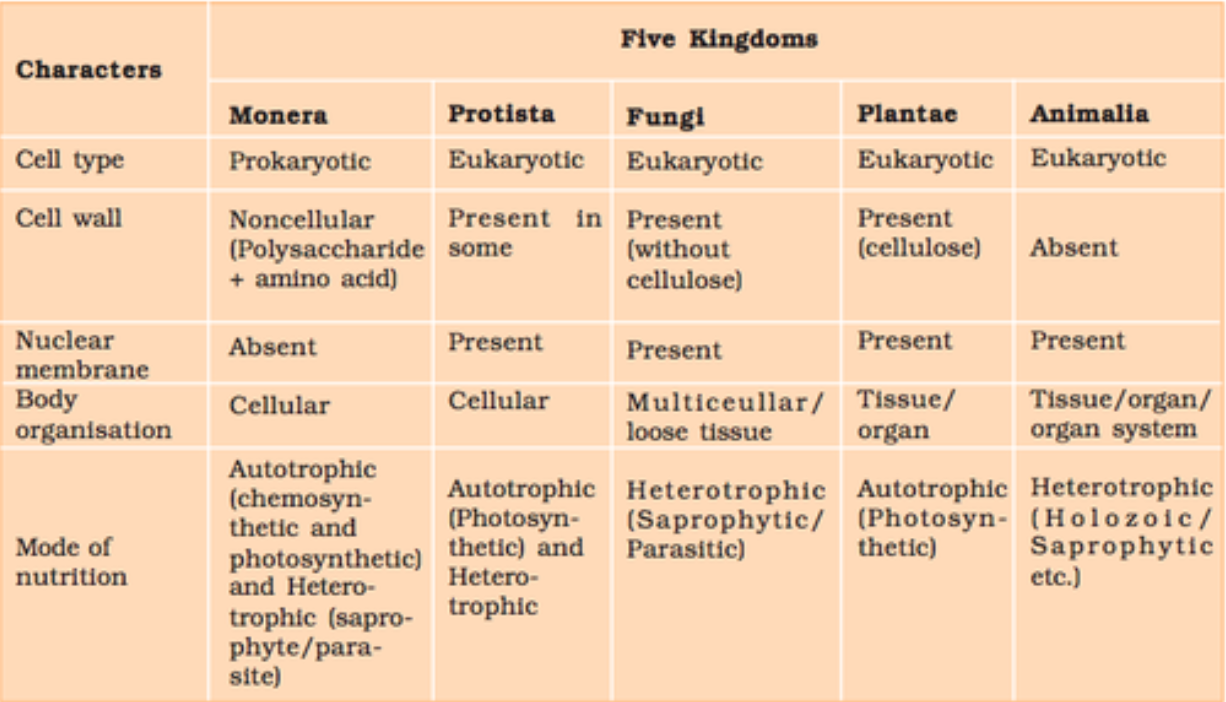
KINGDOM MONERA
- Yeh sabse ancient, smallest or simplest prokaryotes hote hai matlab wo organisms jo unicellular organisms hote hai jinme nucleus pe koi membrane nai hoti. Yeh primitive organism hote hai jinme kuch bhi well developed nai hota matlab bhut hi simple organisms hote hain. Yahi wo organisms hai jo sabse pehle earth pe ae the. Yeh autotroph (jo apna khana khud bana skte hai) ya heterotroph (jo apna khana khud nahi bana skte) kuch bhi ho sakte hain. Inme single strand wala flagella hota hai or inke cytoplasm mein membrane wale organelles nai hote. Inko hum further true bacteria, actinomycetes, cyanobacteria or blue green algae, mycoplasma and archaebacteria mein divide kar sakte hain.
- True bacteria wo bacteria hote hain jo unicellular or sabse kam complex bacteria hain. Inki cell wall peptidoglycan ki bani hoti hai or yeh kai tarah ke shapes mein paye jate hain jaise spherical, rod shape etc.
- Actinomycetes bhi unicellular matlab single cell wale hote hain or inme bhi filament hota hai or yeh jadatar soil, fresh water ya food products mein hote hain.
- Cyanobacteria ya jise blue green algae bhi kehte hai yeh photosynthetic or prokaryotic hote hai. Inme chlorophyll 'a' hota hai or kyuki yeh photosynthetic hote hai islia inme photosynthetic pigment present hota hai jisse wo light ki presence mein apna khana bana pate hain.
- Mycoplasma bhi unicellular prokaryotes hote hai lkin yeh motile nai hote yani yeh chal fir nai sakte or inme proper cell wall bhi nai hoti. Yeh jadatar parasite yani plants or animals pe dependent rehte hain.
- Archaebacteria ek tarah ke unique prokaryotes hote hain jo ki extreme environment yani bhut jada garmi or sardi mein bhi survive kar skte hain. Inme nuclei nai hota isliye yeh bhi prokaryotes hi hote hain.
KINGDOM MONERA
- These are prokaryotes which means nuclear materials are not membrane bound in them.
- They may or may not have a cell wall.
- They can be autotrophic or heterotrophic.
- The cytoplasm of these organisms is devoid of membrane bound organelles i.e mitochondria, plastids, golgi apparatus, lysosomes, endoplasmic reticulum, etc.
- All organisms of this kingdom are unicellular.
- Single stranded flagella are present in many monerans.
- Examples: Bacteria, blue green algae (cyanobacteria) and mycoplasma.

- True bacteria: They are unicellular and least complex. The cell wall is composed of peptidoglycan. The cells vary in shape like spherical(cocci), rod-shaped(bacilli), corkscrew shaped(spirillum) or filamentous.
- Actinomycetes: It is a group of unicellular branched, filamentous bacteria which occur most commonly in soil, fresh water, food products, etc. Example, Streptomyces, Mycobacterium, Actinomyces.
- Cyanobacteria(blue green algae): They are photosynthetic, prokaryotic organisms. They contain chlorophyll 'a' and other photosynthetic pigments and therefore synthesize carbohydrate food in the presence of light by the process known as oxygenic photosynthesis. Eg, Nostoc, Anabaena.
- Mycoplasma: They are unicellular, non motile prokaryotes which lack a distinct cell wall. They occur parasitically in plants and animals and in human beings. Eg, Mycoplasma pneumonia.
- Archaebacteria: They are unique prokaryotes which live in the most extreme of environments. They constitute a domain of single celled organisms. They lack nuclei and are therefore prokaryotes. Different types of archaebacteria are given below :


It is the most ancient, the smallest, the simplest and the most plentiful prokaryotes. They are the most primitive. They were the first inhabitants of the earth. Monerans are characterized by the following:
Kingdom Monera includes true bacteria, actinomycetes, cyanobacteria or blue green algae, mycoplasma and archaebacteria.
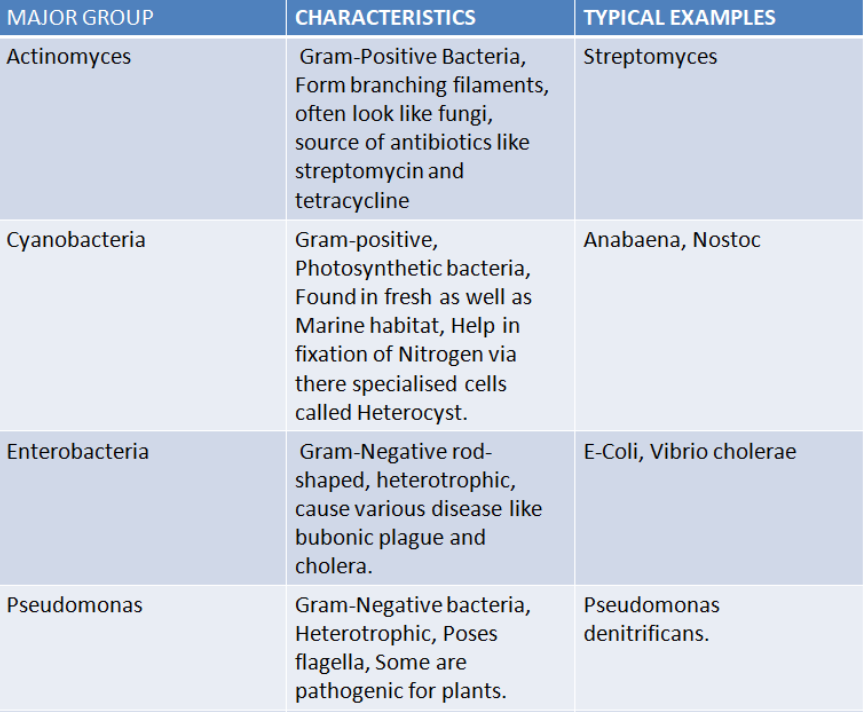
KINGDOM PROTISTA
- Inme eukaryotic organisms ate hain jinme well defined nucleus present hota hai lkin hote yeh bhi unicellular hi hai. Yeh jadatar wo organisms hote hai jo pani mein rehte hain. Inke cytoplasm mein jo cell organelles present hote hai unme membrane present hoti hai. Inka genetic material linear, double stranded hota hai jinme helical DNA hota hai sath hi sath inme chromosomes bhi hote hain. Inme kuch organisms aise hote hain jo flagella ya cilia use krte hai locomotion ke lia. Inka mode of nutrition autotrophic ya heterotrophic kuch bhi ho sakta hai.
KINGDOM PROTISTA
- These are eukaryotic and unicellular.
- They are mostly aquatic and live where there is water.
- The genetic material is the linear, double stranded, helical DNA, complexed with protein, organised into distinct chromosomes.
- The chromosomes are enclosed by a nuclear envelope. Nucleolus is present.
- The cytoplasm contains membrane bound organelles.
- Some organisms use cilia or flagella for locomotion.
- They can be autotrophic or heterotrophic.
- Examples: Plants like unicellular algae, diatoms; animals like protozoans (Amoeba, Paramecium, Euglena)

They include unicellular eukaryotic organisms. They are characterised by the following:
KINGDOM FUNGI
- Fungi thalloid (thallus ka matlab hai ki inki body roots, stems and leaves me bati hui nahi hoti.) organisms hote hai yani jinme roots, stems or leaves alag alag nai hoti. Yeh unicellular ya multicellular kuch bhi ho skte hai lkin eukaryotic organisms hote hai. Yeh heterotrophs hote hai yani yeh apna khana khud nai banate kyuki inme chlorophyll nai hota. Inka mode of nutrition saprophytic hota hai yani yeh dead or decaying matter ko khate hai. Kuch fungi symbiotic relationship bhi rakhti hai with other organisms jaise ki lichens ke sath or kuch parasite bhi hoti hai. Inme asexual reproduction spores se or sexual reproduction sex organs ke formation or gametes ke fusion se hota hai. Examples : Mushrooms
KINGDOM FUNGI
- These are eukaryotic organisms with a cell wall made up of chitin or cellulose or both.
- They do not perform Photosynthesis (Heterotrophs) as they lack chlorophyll.
- They are thalloid, unicellular(yeast) or multicellular, filamentous or mycelial.
- They feed on decaying organic materials. Such a mode of nutrition is called saprophytic. Some fungi live in symbiotic relationships with other organisms (Lichens), while some are parasites as well.
- The reserve food material is in the form of glycogen and oil globules.
- Asexual reproduction occurs by formation of spores and sexual reproduction by the formation and fusion of gametes, produced by sex organs.
- Examples: Mushrooms(Agaricus), green mold(Penicillium), smut(Aspergillus).

Fungi is a group of those organisms whose form is a thallus(not differentiated into roots, stems and leaves), build up of single cell or cells i.e unicellular or multicellular that possess definite cell wall(containing cellulose or chitin or both) and true nucleus(eukaryotic) but lack chlorophyll and differentiation of vascular tissues.
They are characterised by the following:
KINGDOM PLANTAE
- Kingdom plantae se apko kya samajh ara hai. Iske naam se hi pata chal raha hai ki isme wo plants aate hai jo multicellular, eukaryotic or autotrophs hote hain. Inme chlorophyll present hota hai jisse yeh apna khana khud bana pate hain. Inki cells mein ek large central vacuole present hota hai or cell wall cellulose ki bani hoti hai. Inme reserve food starch or fat ke form mein hota hai. Jaisa aap bhi jante hai plants ek jagah se dusri jagah nai jaa skte yani yeh non motile hote hain or substratum se attached rehte hain. Inme growth koi specific time ke lia nai hoti or hamesha growth hoti hi rehti hai. Plants hi hai jo pure biosphere ke lia producers ka kaam krte hain. Yani yahi hame food provide karte hain.
Plants ko hum further divisions meine divide krte hain unke components ke basis pe, unme kis tarah ke special tissue present hai jisse transportation ho food or water ka or is basis pe ki unme seeds hai ya nai. Hai to wo naked hai ya enclosed. To in baton ko dhyaan mein rakh ke hum plants ko five divisions mein divide krte hain. Thallophyta, Bryophyta, Pteridophyta, Gymnosperms or Angiosperms.
Division Thallophyta jise hum algae bhi kehte hain. Yeh ek tarah ka basic plants kehlate hain kyuki inki body undifferentiated hoti hai mtlab thallus like hoti hai. Yeh aquatic hote hai. Aap log jante honge agr local language mein bola jae to ise kae kehte hai jo green color ki hoti hai or jaha pani bhara hota hai waha jam jati hai. Isme chlorophyll hota hai islia yeh green color ki hoti hai. Yeh photoautotrophs bhi hote hain.
Division Bryophyta mein simple or primitive type ke non vascular yani jinme vascular tissue nai hote water, mineral or food ke transport ke lia aise plants aate hain jinki life cycle mein embryo stage aati hai. Yeh land or water dono jagah milte hain islia inhe amphibians kehte hain plant kingdom ka. Yeh plants ki body haploid hote hai jo responsible hoti hai gametes banane ke lia jise gametophyte kehte hain. Inme sex organs multicellular hote hain jisme male sex organ ko antheridia or female sex organ ko archegonia kehte hain.
Division Pteridophyta mein pehli baar vascular plants aate hain. Yeh plants sporophyte hote hain or inki body root, stem or leaves mein differentiated rhti hai. Ab kyuki inme vascular plants ate hain mtlb ki unme vascular tissue jaise ki xylem or phloem present hota hai. Inme sirf spores ke through hi reproduction hota hai sporangia mein. Yeh plants homosporous ya hetrosporous ho skte hain. In plants mein seeds ya flowers nahi hote islia inhe cryptogams kehte hain.
Division Gymnosperms do words se milkar bana hai gymnos matlab naked or sperma matlab seeds. Iska matlab hai ki inme seeds hote hai lkin wo naked hote hain kisi bhi fruit mein enclosed nai hote. Yeh plants perennial hote hai mtlb salon tak zinda rehte hain. Sath hi sath ye evergreen or woody bhi hote hain. Inme sporophyll aggregate hoke cones bana leta hai. Inme separate male or female cones present hote hain. Male spore yani pollen grains jo microsporangia mein bante hain or Female eggs ovule mein bante hain. Gymnosperms mein yahi ovules ovaries mein enclosed nai hote islia yeh naked hote hain. Inme pollination jadatar wind ki wajah se hota hai. Fertilization ke baad ovules seeds ban jate hain. Iska example hai pinus etc.
Division Angiosperms mein seeds covered hote hain. Yeh vascular plants hote hain jinme flowers produce hote hain or in flowers mein stamen or carpels present hote hain. Islia inhe flowering plants bhi kaha jata hai. Stamen male reproductive organ hota hai jo pollen grains banate hain or Carpel female reproductive organ hota hai jisme ovules hote hain. Fertilization ke baad ovules seeds mein develop ho jate hain or ovary fruit mein. Inke seeds mein cotyledons, plumule or radicle hota hai. Plumule yani future shoot, radicle yani future root or cotyledons yani seed ki leaves. Agar kisi seed mein ek cotyledon hota hai to use monocot kehte hai jaise ki maize yani makka meine hota hai. Or agar kisi seed mein do cotyledon hote hain to use dicot kehte hai jaise ki chane mein hote hai.
KINGDOM PLANTAE
- This kingdom includes all multicellular, eukaryotic, autotrophic plants which use chlorophyll for photosynthesis. Some important characteristics of kingdom plantae are:
- These are multicellular and autotrophic.
- Presence of chlorophyll is a distinct characteristic of plants, because of which they are capable of taking photosynthesis.
- Cells have a large central vacuole and a rigid cell wall composed of cellulose.
- The reserve food material is starch and fat.
- They are mostly non mobile, being attached to substratum. A few forms are free floating in fresh or sea water.
- Their growth is indefinite and new organs are continuously added throughout life.
- They are the producers of food in the biosphere.
- Components of Plants – whether they are distinct or not.
- Presence of Special Tissues in plants for the transportation of food and water.
- Presence of Seeds – whether the seeds are present inside the fruits or not.
- Commonly known as algae.
- Basic and elementary plants with undifferentiated body parts (thallus type).
- The plant body may be unicellular (Chlamydomonas, Chlorella), colonial(Volvox, Hydrodictyon), filamentous unbranched(Spirogyra, Ulothrix), filamentous branched(Chara, Cladophora), heterotrichous(Ectocarpus), or foliaceous(Laminaria, Ulva, Fucus, Sargassum).
- They are aquatic, occur both in marine as well as fresh water. However some are terrestrial and grow in moist places.
- Algal cells have chlorophyll. Thus they are photoautotrophs.
- Reproduce through spores.
- Reproductive organs are unicellular non jacketed gametangia.
- After fertilization, the embryo is not formed.
- It includes the simplest and most primitive non vascular land plants having an embryo stage in their life cycle.
- Vascular system is absent, which means there is no specialized tissue for transportation of water, minerals and food.
- Found on both land and water therefore known as ‘Amphibians of Plantae kingdom’.
- The main plant body is gametophyte (haploid body responsible to produce gametes). It is a flat, green thallus and lacks true leaves and roots.
- Plants are fixed by means of hair like rhizoids.
- Sex organs are multicellular. The male sex organs are antheridia and female sex organs are archegonia.
- An embryo is formed by fertilization. Sporophytes live as a parasite over gametophytes.
- Examples: Moss (Funaria), Liverwort (Riccia, Marchantia), Hornwort (Anthoceros), etc.
- This division includes first vascular land plants.The plants are Sporophytes and the plant body is differentiated into root, stem and leaf.
- All the parts of the plant possess vascular tissue (i.e xylem and phloem).
- Reproductions occur only by spores produced in sporangia. The plants may be homosporous or heterosporous.
- Sex organs are multicellular and jacketed.
- Plants do not bear seeds and flowers and hence are called cryptogams. A thin film of water is required for swimming of male gametes to reach archegonia.
- Fertilized eggs develop into embryos.
- Examples: Marsilea, Lycopodium, Selaginella, pteridium, etc.
- The word ‘gymnos’ means naked and ‘sperma’ means seed.
- Plants have naked seeds without fruits or flowers.
- They are perennial, evergreen and woody plants.
- Sporophyll are aggregated to form cones. There are separate male and female cones.
- The male spores are called microspores or the pollen grains. They are produced inside the microsporangia.
- The female egg is formed inside the ovule. In gymnosperms these ovules are not enclosed within the ovaries so they are naked.
- Pollination usually occurs through wind.
- After fertilization, the ovules become seeds. Thus the seeds are naked and not enclosed inside the fruits.
- Examples: Pine, Cycas, Deodar, etc.
- The seeds are covered as the word ‘angios’ means covered.
- It includes those vascular plants which produce flowers. The flowers bear stamen and carpels.
- Thus they are also known as flower-bearing or flowering plants.
- The stamen is male reproductive organ which produces pollen grains. The female reproductive organ is carpel which bears ovules.
- After fertilization, the ovules develop into seeds and the ovary develops into fruit.
- The seeds are protected and enclosed within fruits.
- The seeds that enclose embryos have structures called cotyledons, plumule (future shoot), radicle (future root).
- Cotyledons: Cotyledons are called ‘seed leaves’ because in many instances they emerge and become green when the seed germinates.
Kingdom Plantae is further divided into different divisions on the basis of:
On the basis of above mentioned points, the classification of kingdom plantae is as follows:
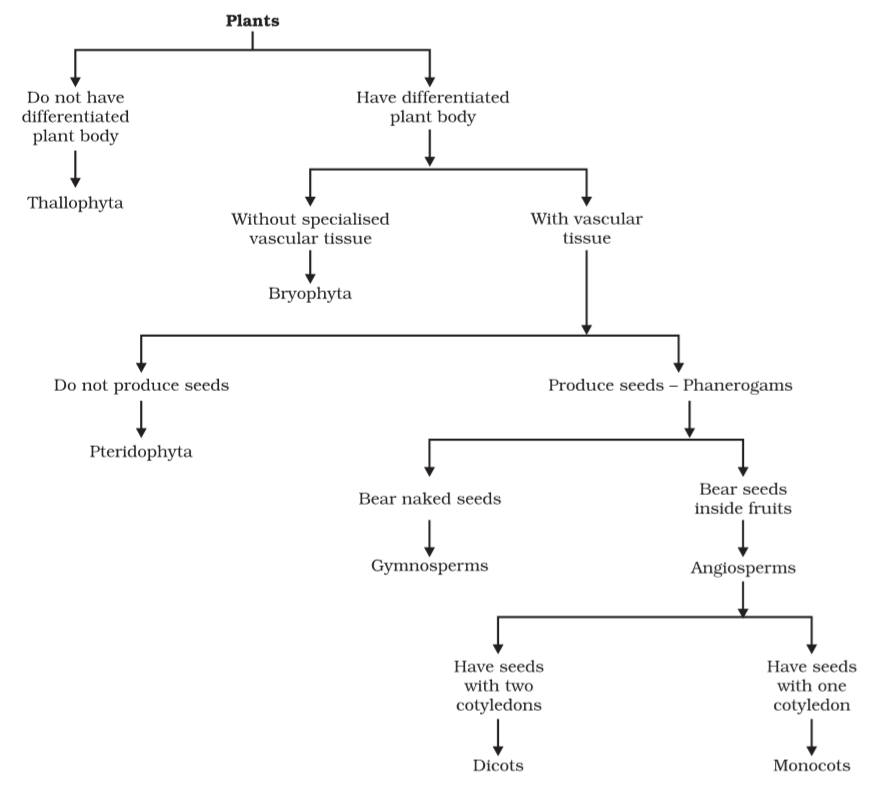
Thus kingdom plantae include the following 5 divisions:
1. Division Thallophyta:
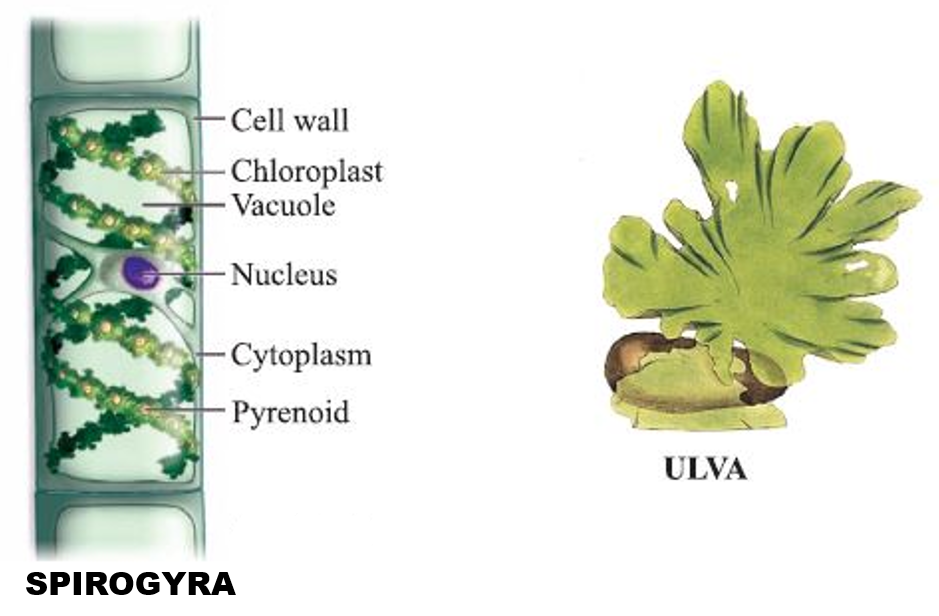
2. Division Bryophyta:

3. Division Pteridophyta:


4. Division Gymnosperms:
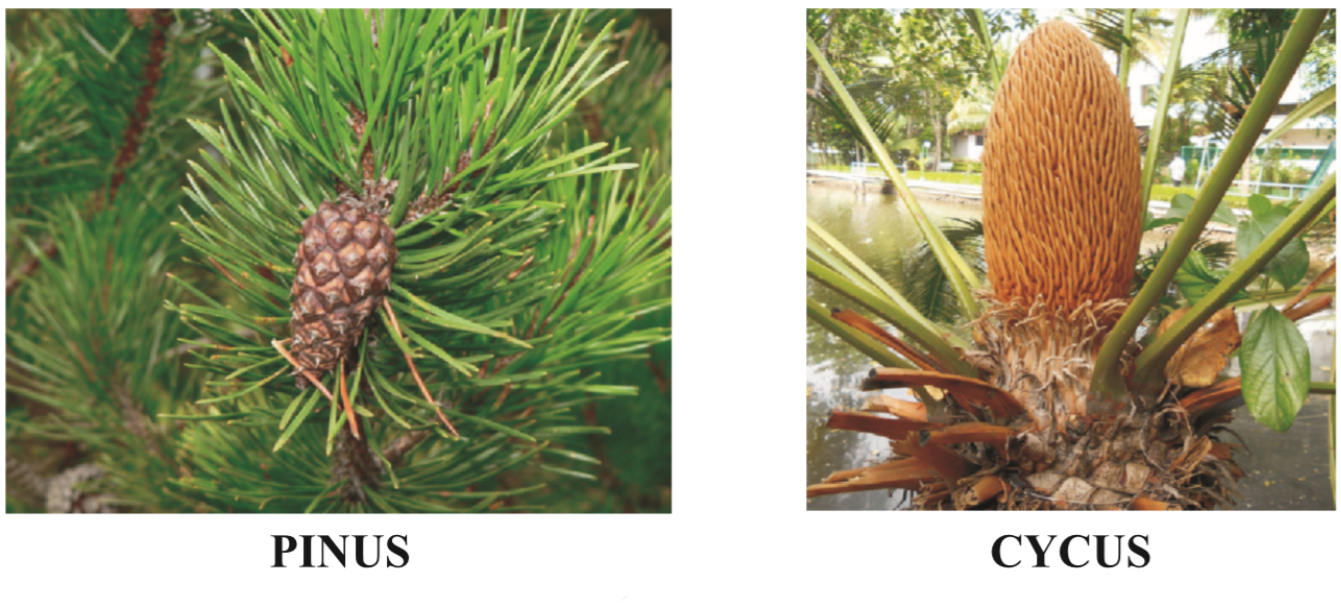

5. Division Angiosperms:

On the basis of the number of cotyledons present in the seed, angiosperms are divided into two groups
(a) Monocotyledonous: Seeds have a single cotyledon. For examples: wheat, rice, maize, etc.
(b) Dicotyledonous: Seeds have two cotyledons. For example: Mustard, gram, mango, etc.
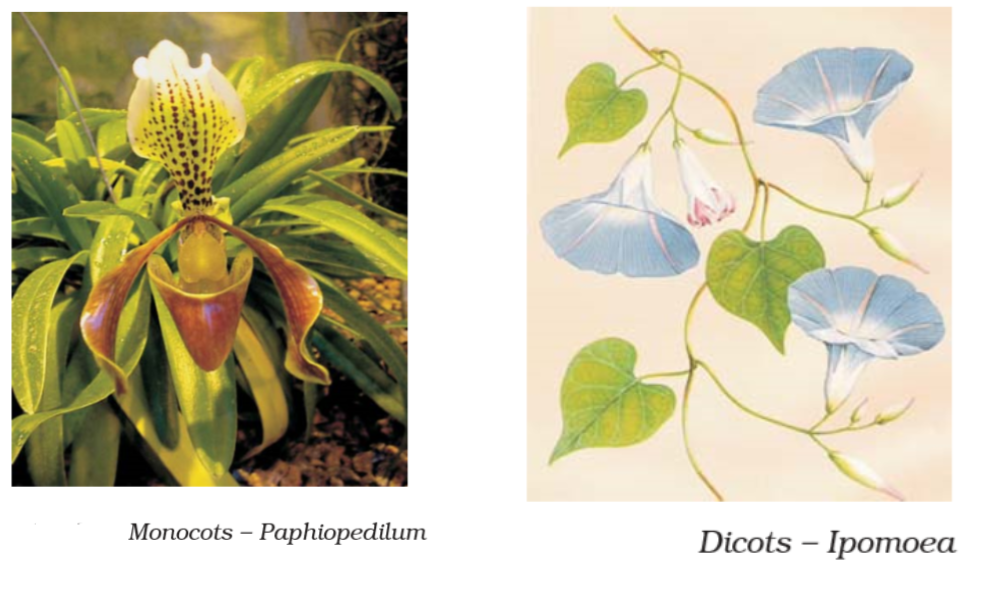
Monocots vs Dicots
| Monocots | Dicots |
|---|---|
| Fibrous roots | Mainly tap roots |
| Flase or hollow stem | Solid stem |
| Parallel Venation | Reticulate Venation |
| Flowers : 3 or in multiple of three (trimerous) | Flowers : 5 or in multiple of five (pentamerous), could be tetramerous also. |
KINGDOM ANIMALIA
- Kingdom Animalia jisme sare animals aate hain. Pancho kingdoms mein yeh kingdom sabse bada hota hai. Yeh eukaryotic, multicellular or heterotrophic organisms hote hai yani jo apna khana khud nai banate. Inme cell wall, plastids or central vacuoles nahi hote but small vacuole ho skte hain. Inka mode of nutrition holozoic hota hai matlab ki organism food ko khata hai digest krta hai or fir use absorb bhi karta hai. Jadatar animals motile hi hote hai jo khi bhi aa jaa skte hain.
Kingdom Animalia ko hum Structural organisation, Body symmetry, Presence or absence of notochord, body cavity, germ layers or mouth ke origin ke basis pe further phylums mein divide kar sakte hain.
Basis of Classification
- Animals kuch fundamental features ke basis pe classify kia jate hain jaise ki: Level of organisation, body plan, symmetry, germinal layer, coelum, notochord, segment etc.
- Chaar major type of organisation hote hain:
- Cellular leve l: Isme cells loosely aggregated rehti hain. Eg: sponges
- Tissue level : Isme jo cells same function perform krti hai wo arrange hoke tissue banati hain. Eg: Coelenterates.
- Organ level : Jaise cells milkar tissue banati hai uske baad tissues milkar organ banate hain, or har organ ka apna ek specialized function hota hai. Eg: Platyhelminthes.
- Organ system level : Organs fir baad mein milkar ek functional system banate hain. Eg: Annelids, Arthropods, Molluscs, Echinoderms and Chordates.
- Yeh body ke jo fluids hote hain unko circulate krwane mein help karta hai. Yeh do tarah ka hota hai:
- Open type : Isme blood confined blood vessels me nai flow krta or heart puri body ko blood pump karta hai. Kyuki isme blood vessels nai hoti to cells or tissues directly ath karte hain blood mein.
- Close type : Isme blood blood vessels ke through hi flow karta hai.(arteries, veins and capillaries.)
- Animals me teen basic body plans hote hain :
- Cell aggregate body plan : Isme body basically aggregation of cells hoti hai jo ki tissues or organs mein organised rehte hain. Inme cell differentiation almost hota hi nahi h. Eg: Sponges.
- Blind sac body plan : Yeh coelenterates or flatworms mein present rehte hai. Inki body ek sac ke form mein hoti hai jisme ek single cavity, digestive tract, single outlet or ek mouth hota hai. Yeh ek hi mouth food ko andar lene ke lia or fecal matter ke waste ko bahar fekne ke lia use hota hai. Inme cells ache se differentiated hote hain.
- Tube within tube body plan : Yeh baki sare bache hue groups mein hota hai. Inki body mein doo tubes hoti hain. Jisme se ek outer body wall hoti hai or ek inner digestive tract. Jo inner tube ki cells hoti hai wo specialized hoti hai to digest food, absorb digestion products and move the food through the body. Jo digestive tract hai usme mouth hota hai for ingestion of food at one end or ek cloacal aperture hota hai jo anus hota hai jisse egestion ho ske feces ka yeh dusre end pe present hota hai. Yeh tube within tube plan do tarah ka hota hai: Protostomes and Deuterostomes.
- Protostomes : Isme embryo mein pehle mouth banta hai or anus opposite end pe hota hai. Yeh jadatar chordates (Flatworms, Roundworms, Annelids, Molluscs and Arthropods) mein hota hai. Yeah animals ke group ko Protostomia kehte hain.
- Deuterostomes : Inke embryo mein pehle anus develop hota hai or mouth opposite end pe hota hai. Yeh plan echinoderms, hemichordates or chordates mein hota hai. Yeh animals ke group ko deuterostomia kehte hain.
- Symmetry wo arrangement hai hamari body ki jisme hamari body ka ek side duse se similar hota hai. Matlab agar hum use beech se do hisso me divide kre to dono hisse barabar ho. Animals me 4 tarah ki symmetry payi jati hai:
- Asymmetrical : Yeh wo symmetry hai jisme median plane se divide krne pe yanii beech se divide krne pe kisi bhi cheej ke doo equal half nai hote. Eg. sponges.
- Radial symmetry : Yeh wo symmetry hai jisme kisi hi plane me divide krne se jo central axis se hoke nikalta hai usme organism two identical half mein divide ho skta hai. Eg; Coelenterates, Ctenophores and Echinoderms.
- Bilateral symmetry : Isme sirf ek hi plane organism ko two identical left or right half mein divide kar sakta hai. Eg; Annelids and Arthropods.
- Biradial symmetry : Isme two planes pass hote hai central axis se jo organism ko identical halves mein divide karte hain.
- Kisi organism mein kitni embryonic layers hain iss basis pe hum organism ko two categories mein divide kar sakte hain :
- Diploblastic : Isme cells do embryonic layers mein arrange rehti hain i.e external ectoderm and internal endoderm. In dono layers ke beech mein mesoglea ki layer hoti hai. Eg; Poriferans and Coelenterates(Cnidarians).
- Triploblastic : Isme developing embryo mein three layers present hoti hain i.e Ectoderm, Mesoderm and Endoderm. Eg; Platyhelminthes to Chordates.
- Wo body cavity jo mesoderm se lined hoti hai use coelom kehte hain. Cavity ka presence or absence hona between body wall and gut wall bahut jaruri hai in the classification. Animals ko hum coelom ke basis pe differentiate kr skte hain:
- Coelomate or Eucoelomate : Inme coelom present hoti hai. Eg; Annelids, Arthropods, molluscs, Echinoderms, Chordates etc.
- Pseudocoelomates : inme true coelom nahi hoti kyuki mesoderm scattered pouches mein hoti hai between ectoderm and endoderm. Eg; Aschelminthes.
- Acoelomates : Inme body cavity nahi hoti. Eg; platyhelminthes.
- Kuch animals mein, body externally or internally segments mein divided rhti hai jinme ek serial repetition hoti hai of some organs. Jaise ki earthworms mein, unki body metameric segmentation show krti hai or isko metamerism kehte hain.
- Yeh ek hollow rod jaisa structure hota hai (dorsal to the gut and ventral to the neural tube) jo ki embryonic stage mein hi ban jata hai on the dorsal side. Yeh mesoderm se derive hota hai. Found only in Chordates. Non chordates mein notochord nahi hoti, like in Porifera to Echinoderms me koi notochord nahi hota.
Level of Organisation :
Circulatory system :
Body Plan :
Symmetry :
Germinal layer :
Coelom :
Segmentation :
Notochord :
In upar ke points ke basis pe hum animals ko nine phylum mein divide karte hain. Ab chalo inhe ek ek karke samjhte hain.
- Phylum Porifera ke animals ko hum sponges kehte hai or ye marine ya fresh water ke organisms hote hai. Ab kyuki ye animals hai to yeh multicellular to hote hain lkin inme koi tissue, organ ya organ system nai hota. Yani inka organisation cellular level ka hota hai. Inki body mein pores hote hai jo ki naam se hi smjh ara hai ki sponge mein pores hote hai jise ostia bhi kehte hai jiske through inki body mein food or water ka circulation hota hai. Inki body pe ek skeleton hota hai bahar ki side jise spicules kehte hai. Sponges sessile hote hai mtlb yeh move nai kr skte ek hi jagah rhte hai. Inme koi symmetry nahi hoti yani ke yeah asymmetrical hote hai and reproduction sexual as well as asexual dono tarah se hota hai.
Phylum Coelenterata jise Cnidaria bhi kehte hai. Yeh organisms aquatic hote hai or jadatar colonies mein rehte hai. Inki body do layers se bani hoti hai islia inhe diploblastic kehte hai. Inme organisation tissue level ka hota hai yani inme tissues hote hai lkin organ or organ system nai hota. Inki body mein cavity present hoti haai islia inka naam coelenterate hai. Inme radial symmetry hoti hai or usually reproduction asexual hota hai in polyp form or sexual hota hai medusa form mein.
Phlum Platyhelminthes : Platy ka matlab hai flat and helminth ka matlab hai worm. Toh yeah aise worms nhai jo uper and neeche se chapte yani ki flat hote hai. Body inki bilaterally symmetrical hai and triploblastic hai but inme koi true body cavity nahi hoti toh inko acoelomate bola jata hai.. Yeah free living bhi ho sakte hai and parasitic bhi. examples hai : Liverflukes, Planaria, Tapeworm
Ab baat krte hain Phylum Nematode ki. Inki body mein teen layers hoti hai islia inhe triploblastic kehte hain. Inme bilateral symmetry hoti hai. Inki body pe ek tough or resistant wall hoti hai or inme cilia nai hota. Abhi tak ke phylum mein humne dekha tha ki unme coelom nai hota lkin is phylum mein pseudocoelom hota hai matlab ki body wall or digestive tract ke beech mein jo cavity hoti hai wo true nai hoti. Inme one way alimentary canal bhi hoti hai jisme mouth or anus dono hote hain. Matlab ek complete digestive tract present hota hai. Inme sex separate rehta hai. Is phylum mein wo animals ate hain jo generally parasite hote hai or koi na koi disease krte hai.
Phylum Annelida : Chalo ab Annelida phylum ke baare mein baat karte hain. Is phylum mein segmented worms ate hai jaise ki earthworm jinhe hum kehte hai ki ye farmers ke best friend hote hain kyuki yeh soil ko upjau banane mein help krte hain. Yeh geeli mitti ya fr fresh water ya sea mein rehte hai. Inki body bhi bilateral symmetry wali or triploblastic hoti hai. Ab kyuki humne padha ki inki body mein segments hote hai to inki body ke aage ke segments head form kar lete hai. Nematoda mein hmne dkha tha ki unme pseudocoelom hota hai lkin ab is phylum se true coelom hota hai yani ek true cavity present hoti hai body mein. In organisms ki body mein paired parapodia appendage hai jo locomotion mein help krte hain. Inme bhi alimentary canal complete hoti hai or hume ek closed circulatory system dekhne ko milta hai. Inme reproduction sexually hi hota hai. Agar sexes seperate hote hai to unhe unisexual kehte hain or united hote hai to hermaphrodite.
Phylum Arthropoda ki baat kare to yeh sabse bada phylum hai in terms of no of species. Isme jitne bhi keede makode hote hai jaise prawn, crab, butterfly, insects, etc sb aate hai. In animals mein jointed legs hote hai isliye inka naam hai arthropoda. Yeh land, soil, freshwater har jagah hoti hai. Inki body bahar se to segmented hoti hai lekin internally nahi hoti. Inme ek tough exoskeleton hota hai jo chitin se bana hota hai. Inki body ke aage ke hisse mein ek head or kuch fused segments hote hai. In animals mein sex organ ke sath sath brain bhi hota hai. Inki body cavity reduce ho jati hai or usme blood ane lagta hai islia inhe haemocoel kehte hain. Inki bhi alimentary canal complete hoti hai, mouth mein movable appendages hote hain or anus body ke dusre end pe hota hai. Inme respiration ke lia kisi mein gills to kisi mein trachea ya book lungs ya book gills hote hai.
Phylum Mollusca : Ab baat karte hai phylum mollusca ki to inme ate hai aquatic organisms jaise octopus, oysters etc. Inki body mein bilateral symmetry hoti hai lkin bahar se inki body unsegmented hoti hai. Inki body bahar se ek hard shell se cover rehti hai jo calcium carbonate ka bana hota hai. Inme open circulatory system hota hai matlb inme blood kisi blood vessel wagerah mein nai behta. Sath hi sath inme excretion ke lia ek kidney jaise organ bhi develop ho jata hai. Inki body mein locomotion ke lia muscular feet bhi develop hone lagte hai. Inki body teen region mein divided rehti hai head, visceral mass jisme sense organs hote hai and foot. Inme respiration ke lia gills hote hai or sex bhi seperate hote hai.
Phylum Echinodermata mein star fish, sea cucumber yeh organism aate hai. Yeh spiny yani katedar hote hai. Inme symmetry bhi pentamerous hoti hai jab yeh adult stage mein hote hai lkin jab larvae stage mein hote hain to bilateral symmetry hi hoti hai. Yeh organism bhi tripbloblastic hote hai or inme bhi coelom yani body cavity hoti hai. Inme locomotion ke lia ek water vascular system hota hai matlb pani ki wajah se hi inme movement hoti hai. Lkin kisi bhi echinoderm mein head nai hota hai.
Phylum Chordata : Chalo ab baat karte hain Chordata phylum ki. Inme notochord hoti hai jo ek rod jaisa structure hota hai jo body ko support deta hai. Yeh embryonic stage mein to sabhi chordates mein hoti hai lkin adult stage mein kisi mein hi hoti hai. Inme nerves hoti hai jo brain se judi hoti hai. Inki body mein segmented muscles hoti hai lekin jo trunk hai wo unsegmented hota hai. Inme ek post anal tail hoti hai jo muscles se bani hoti hai. In organism mein complete digestive system hota hai. Dkho chordata further do subphylum mein divide rehta hai jo hai protochordata jisme Balanoglossus, herdmania or vertebrata jisme hum mammals, birds, reptiles, fishes ate hai. Yeh wo organism hai jinhe hum roj dekhte hai or jinke bare mein hum kafi kuch jante bhi hai to inke bare mein detail mein hum agle section mein dekhenge.
KINGDOM ANIMALIA
- Kingdom Animalia constitutes all animals. Amongst the five kingdoms, the largest kingdom is the animal kingdom. The characteristics of this kingdom are:
- They are eukaryotic, multicellular, heterotrophic organisms.
- The cells possess no cell wall and plastids.
- Central vacuoles are absent but small vacuoles may occur.
- Mode of nutrition is holozoic and they are either herbivores or carnivores.
- Most animals are motile, they can move independently in search of food, shelter or mate (except sponges and coelenterates).
- Nutrition is primarily ingestive.
- Reproduction is generally sexual and the haploid stage is represented only by gametes.
- Animals are made up of many organ systems that aids in performing specific functions that are necessary for the survival of the organism.
- Most of the animals are bilaterally symmetrical, while primitive animals are asymmetrical and cnidarians and echinoderms are radially symmetrical.
- Commonly known as sponges. They are mostly marine but one group lives in freshwater.
- Sponges are multicellular animals. There are no tissues, organs and organ systems. Thus they have cellular level of organization.
- These animals have pores (ostia) all over which led to a canal system for circulation of water and food.
- The body is covered with a hard outer layer or skeleton called spicules.
- They are mostly sessile (stalk-less) and attached to the substratum.
- Some sponges are vase-like or cylindrical and have radial symmetry. Others form flat, globular or irregular, branching masses. They are asymmetrical.
- Reproduction is asexual as well as sexual. Asexual reproduction occurs by budding or by special cell masses, termed gemmules. Sexual reproduction involves formation of ova and spermatozoa.
- Examples: Sycon, Spongilla, Euplectelia, etc.
- They may be solitary or colonial. They are all aquatic (both freshwater and marine).
- The body of animals is made of two layers of cells (diploblastic). The animals are multicellular with tissue level of organisation. However, they lack organ and organ systems.
- There is a cavity in the body hence the name Coelenterate (coelom means cavity).
- Symmetry is usually radial.
- Reproduction is usually asexual (budding) in the polyp form and sexual in the medusa form. Fertilization may be external or internal. Gonads are simple without gonoducts.
- The soft body may be supported by horny or calcareous skeleton which is made up of lime. Hard skeletons occur in corals.
- Examples: Hydra, Jellyfish, Sea anemone, etc.
- They are the most primitive. It includes bilaterally symmetrical flatworms.
- The body is flattened from top to bottom and hence they are also named as flatworms.
- The body wall is composed of three layers of cells (triploblastic).
- A true internal body cavity or coelom is absent, hence lacks proper organs.
- The excretory system includes characteristic flame cells (protonephridia) leading into tubules that open out by one or more excretory pores.
- These animals are mostly bisexual (hermaphrodite) i.e both male and female sex organs are present in the same animal.
- They are free-living or parasitic animals.
- Examples: Planaria, liver fluke, tapeworm, etc.
- The body is bilaterally symmetric and triploblastic, cylindrical or flattened and unsegmented.
- The body wall is covered with a tough and resistant cuticle. Cilia is absent.
- A pseudocoelom (cavity present between the body wall and the digestive tract is not a true coelom) is present.
- A straight, one way alimentary canal with mouth as well as anus. This means a complete digestive tract is present.
- Sexes are generally separate.
- This phylum includes animals which are generally parasitic and cause disease. However a few are free living in soil or water.
- Examples: Roundworms, Pinworms, Wuchereria, etc.
- This phylum includes segmented worms such as earthworms, leeches, nereis etc which occur in moist soil, freshwater and sea.
- These are bilaterally symmetrical, triploblastic, soft, elongated, vermiform and cylindrical or dorsiventrally flattened.
- Some of the anterior body segments concentrate to form the head.
- True body cavity is present.
- The body is divided into segments or metamers and hence the name annelida.
- Body has lateral locomotory appendages in the form of segmentally arranged paired parapodia, chitinous setae.
- Extensive Organ differentiation.
- Their alimentary canal is complete, straight and extends through the entire body from mouth to anus.
- A closed circulatory system has appeared.
- The nervous system includes a pharyngeal nerve ring and a solid, double, mid-ventral, nerve cord with ganglia.
- Reproductions occur by sexual mode. The sexes may be seperate (unisexual) or united (hermaphrodite).
- Examples: Earthworm, leech, blood worm, etc.
- This is the largest group of animals in terms of number of species which includes prawns, carbs, insects, spiders, shrimps, centipedes, millipedes, etc.
- Animals have jointed appendages which give the name arthropoda (the word arthropod means jointed legs).
- They occur on land, in soil, freshwater,etc.
- Their body is segmented externally, but not separated internally by septa.
- Tough exoskeleton made of chitin is present.
- They are bilaterally symmetrical and triploblastic.
- Their body’s anterior part forms a distinct head and has many fused segments.
- It bears well developed sense organs and brains.
- The body cavity is reduced and contains blood hence called haemocoel.
- The alimentary canal is complete. Mouth has movable appendages. Anus lies at the opposite end of the body.
- Respiration occurs by a special structure called gills, tracheae, book-lungs, book-gills,etc.
- Sexes are separate.
- Examples: Cockroach, housefly, spider, prawn, scorpion, etc.
- It includes aquatic forms like mussels, oysters, snails, slugs, squids, cuttle fishes, octopus, etc.
- Body is bilaterally symmetrical and unsegmented without external appendages.
- The soft body is covered with a hard shell made of calcium carbonate.
- Circulatory system is open and a kidney like organ is present for excretion.
- The body has well developed muscular feet for locomotion.
- The body is usually differentiated into three regions- anterior head with sense organs, dorsal visceral mass containing organ systems and ventral foot for locomotion.
- Mantle (thin, fleshy fold covering the body) is present. It encloses a cavity called the mantle cavity. The anal, excretory and genital appertures are situated in this cavity.
- The Alimentary canal is complete.
- Respiration usually occurs by gills called ctenidia.
- Sexes are separate.
- Examples: Snail, mussels, octopus, etc.
- They are spiny skinned and free-living, marine, gregarious and slow moving animals like starfish, brittle stars, sea cucumber, etc.
- The animals are usually pentamerous symmetry in adults and bilateral in larvae.
- They are triploblastic and have a coelomic cavity.
- They have a water driven tube system for moving forward called a water vascular system for locomotion.
- All echinoderms lack heads.
- Examples: starfish, sea urchin, sea cucumber, sea lily, etc.
- They have a notochord. It is a rod-shaped structure that provides skeletal support to the body. It is found in the embryonic stage of all chordates and in adult stages for some chordates.
- A nerve cord that connects the brain.
- Most aquatic animals have a Pharyngeal slit that allows the exit of water.
- They have segmented muscles in an unsegmented trunk.
- They have a post-anal Tail made up of muscles and skeletal elements that helps in balancing.
- Exhibit a complete digestive system.
- Animals are bilaterally symmetrical, triploblastic and coelomate.
- Notochord, a long rod-like structure which runs along the back of the animal, is present at least at some stages of life.
- This provides attachment points for muscles.
- It also separates the nervous tissues from the gut.
- Definite organs are present.
- There is no segmentation in the body.
- Examples: Balanoglossus, herdmania, amphioxus, Ascidia, Herdmania, etc.
- Notochord is replaced by the spinal column.
- Dorsal nerve cord is present.
- Animals are triploblastic, coelomate and bilaterally symmetrical.
- Animals have paired gill pouches.
- Body has segmentation and definite organs.
- Examples: Mammals, Birds, Fishes, etc.
- Class Pisces include all bony and cartilaginous fishes.
- They are exclusively aquatic.
- Body is streamlined with paired and unpaired fins.
- Muscular tail is present which assists in locomotion.
- Body is covered with scales.
- These are cold-blooded vertebrates.
- Paired gills are present as respiratory organs.
- Heart is two-chambered.
- Lateral line system is well developed.
- They lay eggs.
- Examples: Sharks (cartilaginous), Rays, Rohu (bony), Mrigal, Green carp, etc.
- Amphibians live both, on land and in water and lay their eggs in water.
- Mucus glands on skin keep the skin moist.
- Respiration is through gills in the larval stage and through lungs in adults.
- They are cold-blooded animals.
- They have a three-chambered heart.
- Examples: frog, toads, salamander, etc.
- These are the first completely land animals.
- These are crawling animals.
- Reptiles are cold-blooded and breathe through their lungs.
- They have a three-chambered heart (except crocodiles- has four chambered hearts) and lay eggs with tough coverings.
- Body is covered with scales, scutes or hard plates.
- They don’t need water to lay eggs, rather eggs are covered with hard shells and laid on land.
- Examples: Snakes, Crocodiles, Turtles, Lizards, etc.
- All birds belong to this class.
- They are warm-blooded, have a four-chambered heart and breathe through lungs.
- They have their forelimbs modified into wings which help in flight.
- Jaws are modified into beaks.
- Bones are hollow (pneumatic) and most of them are fused to reduce body weight to assist in flying.
- An exoskeleton is in the form of feathers.
- Example: Pigeon, Ostrich, Kite, Sparrow, etc.
- They are primarily terrestrial vertebrates. They occur in all sorts of habitats.
- They are warm-blooded, breathe through lungs and have a four-chambered heart.
- Presence of hair on their body, sweat and oil glands are exclusive characteristics of mammals.
- Presence of pinna i.e external ear is also seen only in mammals.
- The body is divisible into head, neck, trunk and tail.
- Sexes are usually distinguishable externally.
- Two pairs of pentadactyl limbs are present.
- They also have the mammary glands to feed their young ones.
- Most animals are viviparous (giving birth to live young ones), some are oviparous (producing eggs).
- Examples: Human, Horse, Chimpanzee, Lion, etc.
Some of the criteria of classifying animals are given below:
(a) Structural organisation of animal body
(b) Body symmetry
(c) Presence or absence of notochord
(d) Presence or absence of body cavity
(e) Germ layers- Diploblastic or Triploblastic
(f) Mode of origin of mouth
On the basis of above mentioned points, the classification of kingdom animalia is as follows:
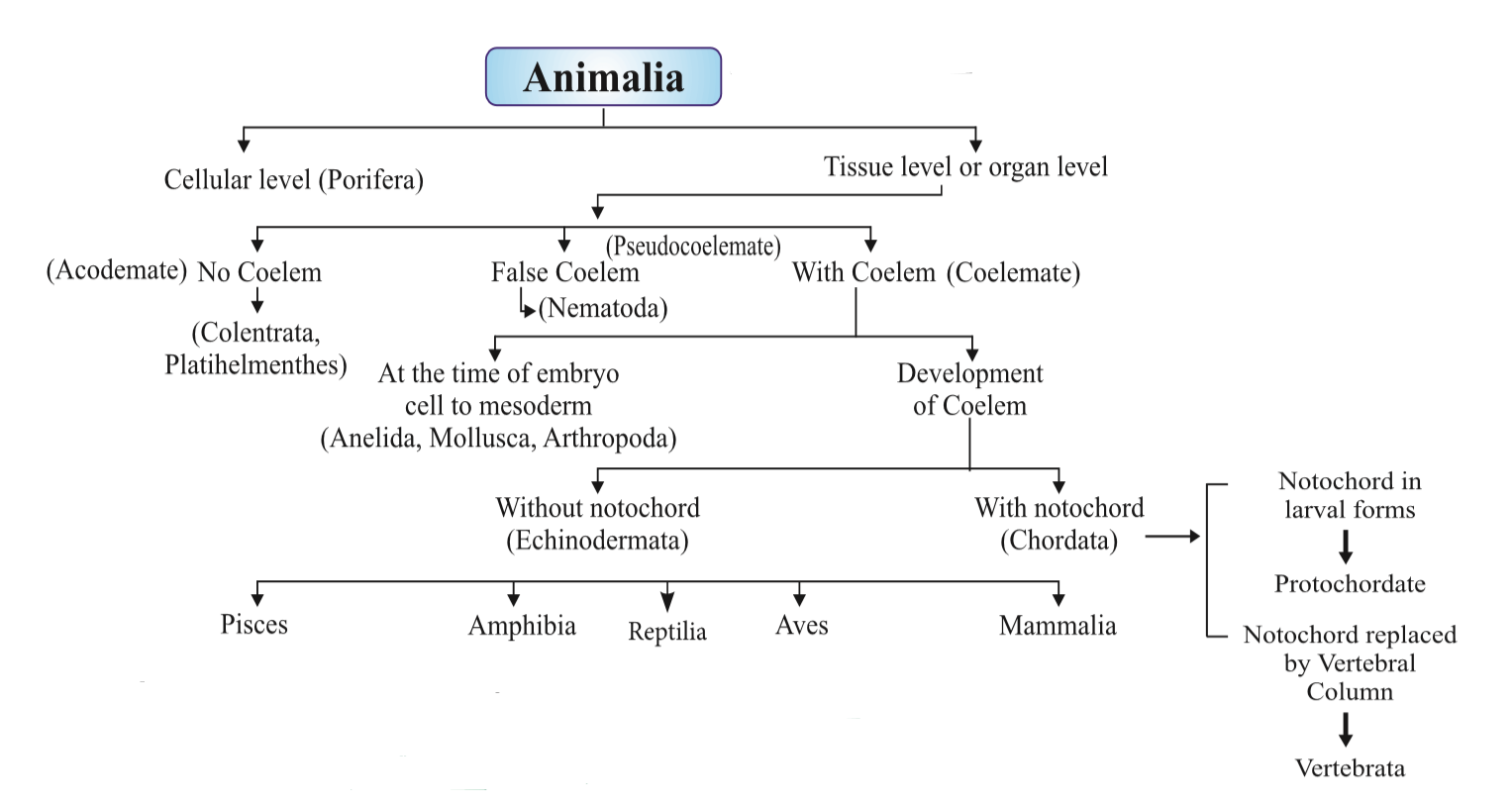
1. Phylum Porifera:

2. Phylum Coelenterata or Cnidaria:

3. Phylum Platyhelminthes:
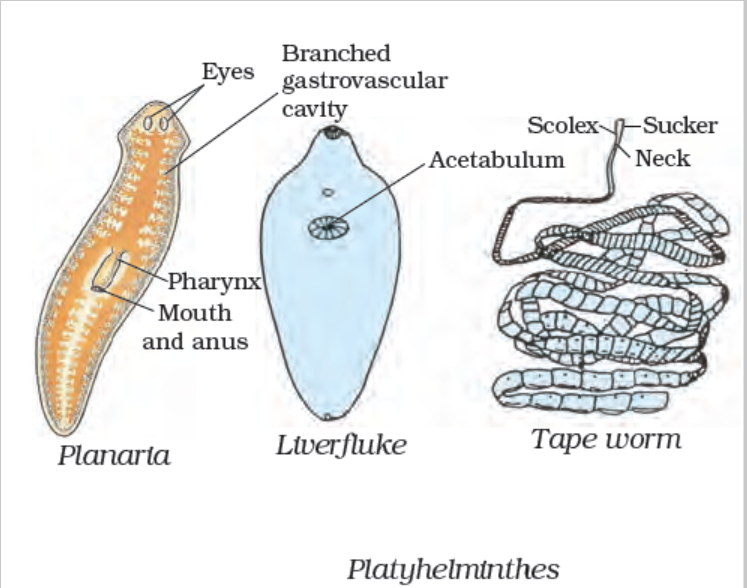
4. Phylum Nematoda or Aschelminthes:
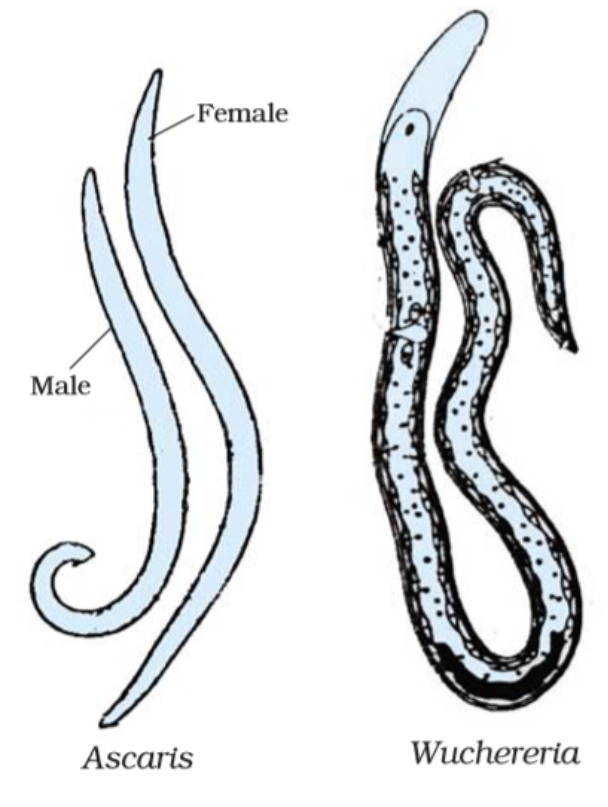
5. Phylum Annelida
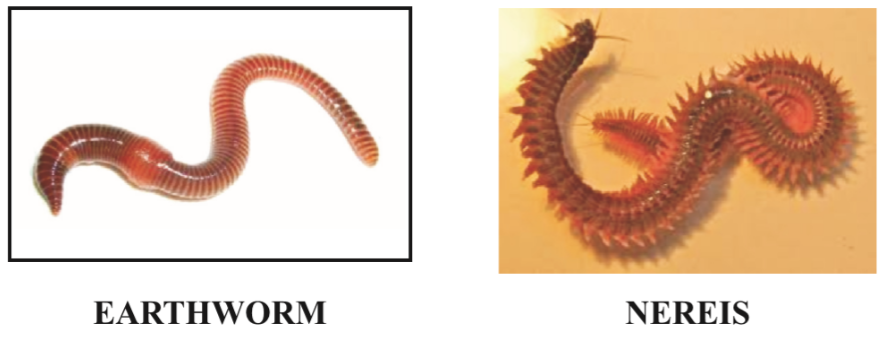
6. Phylum Arthropoda:

7. Phylum Mollusca:
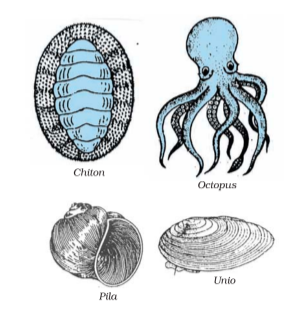
8. Phylum Echinodermata:
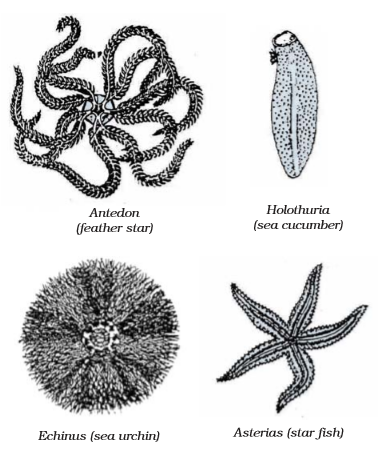
9. Phylum Chordata:
Chordata is further divided into two sub-phylum as explained below:
A. Protochordata:
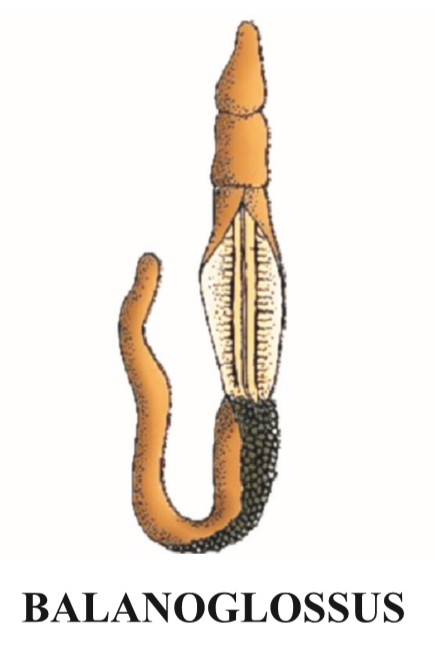
B. Vertebrata:
Now this subphylum vertebrata is divided into seven classes:
(i) Class: Pisces
(ii) Class: Amphibia
(iii) Class: Reptilia
(iv) Class: Aves
(v) Class: Mammalia
Class: PISCES

Class: AMPHIBIA

Class: REPTILIA

Class: AVES

Class: MAMMALIA
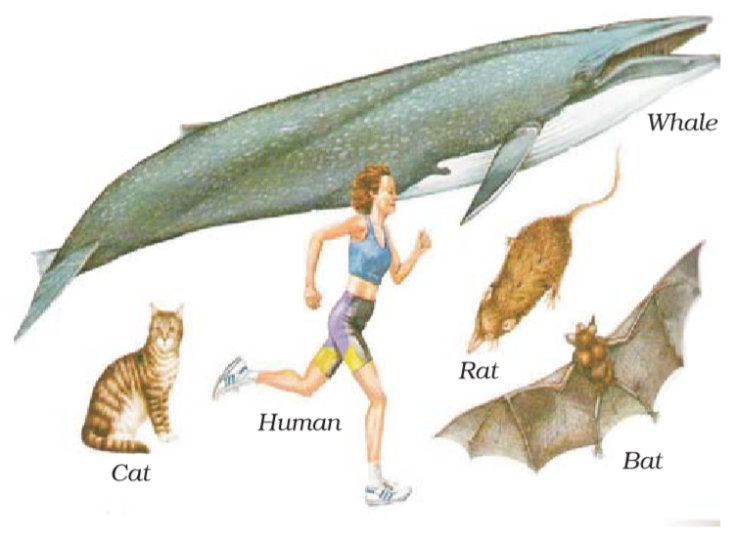


NOMENCLATURE
- Ab dekho nomenclature kya hota hai. Jaise aap sbko pta hi hoga ki hamare desh mein kitti diversity hai languages ki or kitne tarah ke log rehte hai jaise hindu, muslim, sikh, etc. Or kitte sare states bhi hai or har jagah ka apna culture hota hai. Ab dkho kisi ek cheej ka jo naam rajasthan mein hoga wo south mein kerela ke side kuch or hoga kisi or state mein kuch or hoga. To kya yeh possible hai ki hum har jagah ke alag alag naam yaad kre or fir isse toh hume hi dikkat hogi kisi bhi cheej ko jaane mein uske bare mein padhne mein. Or yeh toh hum bs apne desh ki baat kar rhe hai lkin kisi or desh mein bhi to alag alag naam honge to kitta mushkil hoga kisi bhi cheej ko janne mein. Islia ek naming system banaya gaya jise nomenclature kehte hai jisme sbhi organisms ko ek biological name dia gaya jo har jagah same hi hota hai. Is naam ko rkhne ke jo rules hai wo International bodies set krti hai throughout the world isko hum taxonomy kehte hai jisme naming ki jati hai plants animals ya baki species ki. Carolus Linnaeus ek botanist the jinhone yeh bionomial nomenclature ko introduce kia tha or inhe Father of Taxonomy bhi kaha jata hai. Inhone kuch rules banae the naming karne ke liye.
Wo rules hai ki biological name mein do terms hongi first will be genus name and second will be species name. Genus name hamesha capital letter se shuru hoga or species name small letter se. Agar naam printed form mein hai to wo hamesha italics mein likha jaega. Or agar hand written hai to dono genus and species name ko separately underline karna hoga. To yeh hota hai nomenclature or use rules jiske according hi sbhi organisms ko naam dia jate hai. Jaise hum humans ka naam hai Homo sapiens.
NOMENCLATURE
- Naming a correct scientific name to an organism or a taxon is called nomenclature. It involves the principles governed by set rules formulated by International bodies so that a particular organism or taxon is known by its specific name throughout the world.
- The biological name is composed of two terms. The first term is called genus name and the second term is called species name.
- The genus name always begins with a capital letter, while the species name begins with a small letter.
- In print, the scientific name is written in italics.
- When handwritten, the genus name and species name have to be underlined separately.
Taxonomy is the science of naming, describing and classifying organisms and includes all plants, animals and microorganisms of the world.
Carolus Linnaeus is a Swedish botanist and physician who is also called ‘Father of taxonomy‘. He introduced the Binomial nomenclature and laid the ground rules which paved the way for modern taxonomy.
Why is nomenclature required?
It will help people identify an organism with a standard name anywhere in the world. The whole hierarchy of an organism is not mentioned in the name. Only Genus and Species of the organism are mentioned.
Conventions for writing the scientific name:
SUMMARY
- Classification helps us in exploring the diversity of life forms.
- The major characteristics considered for classifying all organisms into five major kingdoms are:
(a) whether they are made of prokaryotic or eukaryotic cells.
(b) whether the cells are living singly or organised into multi-cellular and thus complex organisms.
(c) whether the cells have a cell-wall and whether they prepare their own food. - All living organisms are divided on the above bases into five kingdoms, namely Monera, Protista, Fungi, Plantae and Animalia.
- The classification of life forms is related to their evolution.
- Plantae and Animalia are further divided into subdivisions on the basis of increasing complexity of body organisation.
- Plants are divided into five groups: Thallophytes, Bryophytes, Pteridophytes, Gymnosperms and Angiosperms.
- Animals are divided into ten groups: Porifera, Coelenterata, Platyhelminthes, Nematoda, Annelida, Arthropoda, Mollusca, Echinodermata, Protochordates and Vertebrata.
- The binomial nomenclature makes for a uniform way of identification of the vast diversity of life around us.
- The binomial nomenclature is made up of two words – a generic name and a species epithet.